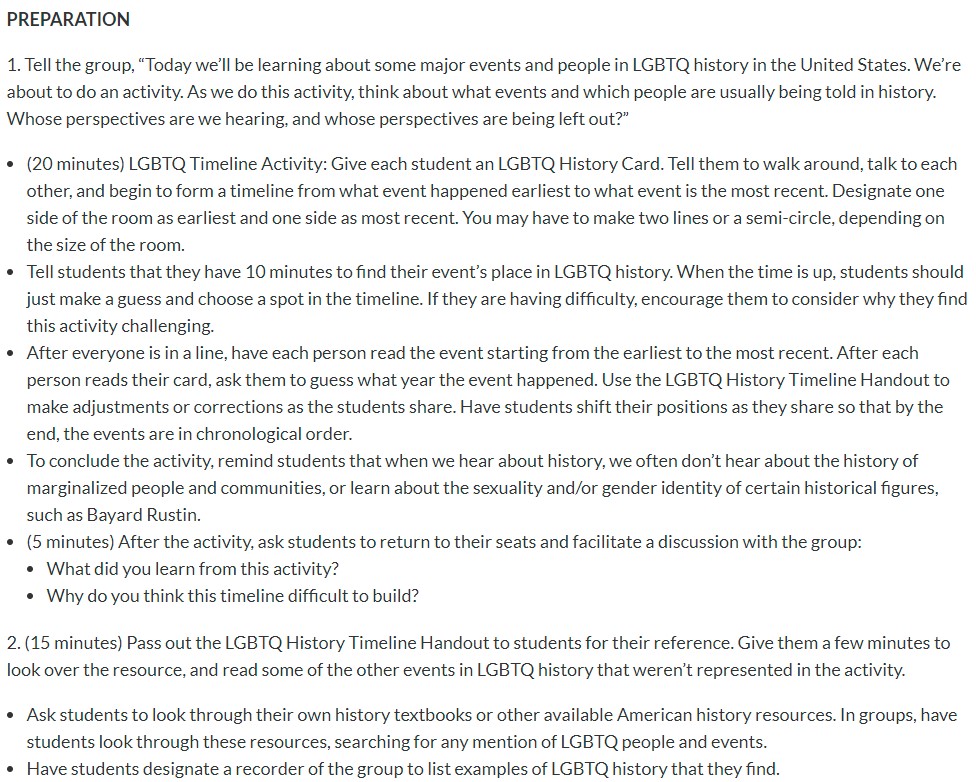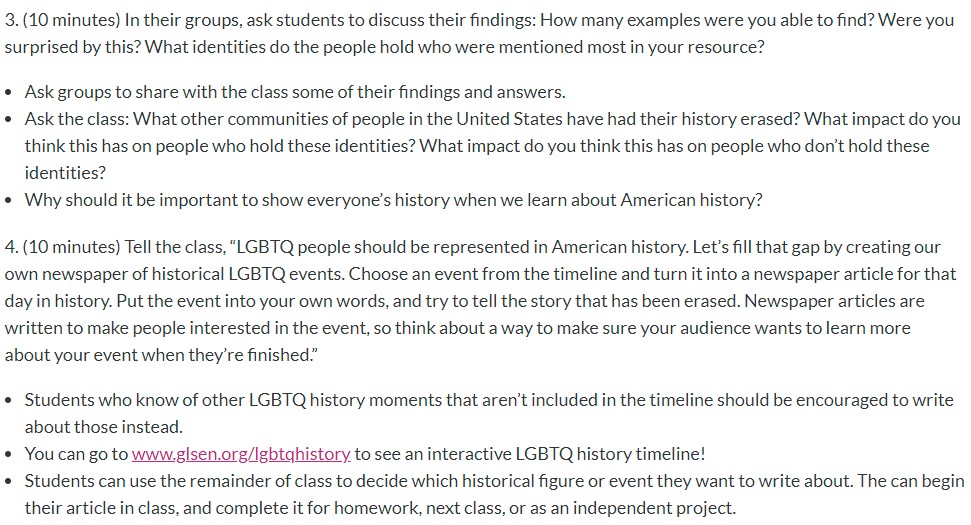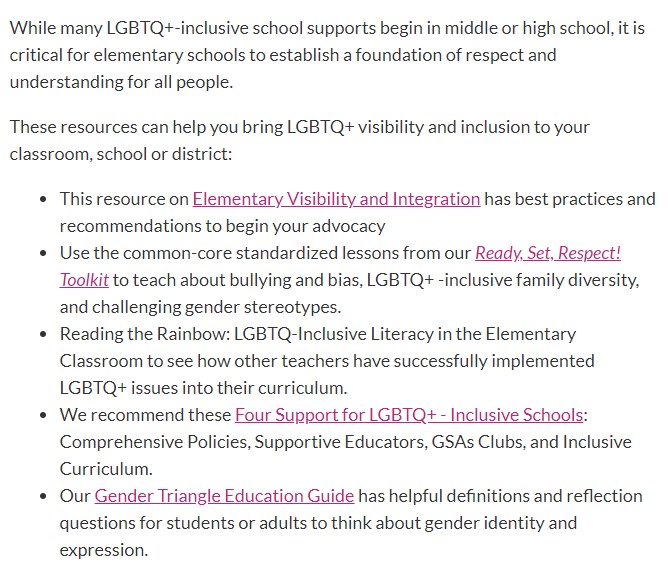
Howell Township Public Schools teaches second graders “how gender-role stereotypes may limit behavior”; mandates that “parental consent is not required” to use the preferred name and pronouns of students
Incidents
Howell Township Public Schools is a district specifically for kindergarten through the eighth grade. On April 14, 2022, Assistant Superintendent Bruce Preston published a letter discussing the school district teaching gender identity to students. In the letter, he provided a link to the district’s 2022 health curriculum. By the end of the second grade, children should be able to “discuss the range of ways people express their gender and how gender-role stereotypes may limit behavior,” according to this curriculum.
By the end of the fifth grade, children should know that “all individuals should feel welcome and included regardless of their gender, gender expression, or sexual orientation.” Children should also be able to “describe gender-role stereotypes and their potential impact on self and others” and to “differentiate between sexual orientation and gender identity.” By the end of the eighth grade, children should be able to “differentiate between gender identity, gender expression and sexual orientation” and be able to “develop a plan for the school to promote dignity and respect for people of all genders, gender identities, gender expressions, and sexual orientations in the school community.”
On April 17, 2019, the school district’s Board of Education adopted a “Transgender Students” policy. The policy includes terminology related to gender identity because “the Board believes students, teachers, and administrators should be provided with common terminology associated with gender identity.” In the definition for the term “transition,” the policy appears to show support for students using “hormone treatments and surgery” in an attempt to transition to another gender. The following are terms and definitions that the policy mentions:
- “Gender identity” means a person’s internal, deeply held sense of gender. All people have a gender identity, not just transgender people. For transgender people, the individual’s internal gender identity is not the same as the gender assigned at birth.
- “Transition” is the process by which a transgender person recognizes that their authentic gender identity is not the same as the gender assigned at birth, and develops a more affirming gender expression that feels authentic. Some individuals socially transition, for example, through dress, use of names and/or pronouns. Some individuals may undergo physical transition, which might include hormone treatments and surgery. School district personnel should avoid the phrase “sex change,” as it is an inaccurate description of the transition process; the process is more accurately described as “gender-confirming.”
- “Gender expansive, Gender diverse, Gender fluid, Gender non-binary, A gender, Gender queer” are terms that convey a wider, more flexible range of gender identity and/or expression than typically associated with the binary gender system. For example, students who identify as gender queer or gender fluid might not identify as boys or girls; for these students, the nonbinary gender identity functions as the student’s gender identity.
The policy specifically mentions that “parental consent is not required” to use a student’s preferred gender identity. The policy states:
The school district shall accept a student’s asserted gender identity; parental consent is not required. A student need not meet any threshold diagnosis or treatment requirements to have his or her gender identity recognized and respected by the school district, school, or school staff members. In addition, a legal or court-ordered name change is not required. There is no affirmative duty for any school district staff member to notify a student’s parent of the student’s gender identity or expression.
If parents discover that the school district is using a student’s preferred name and pronouns and disagree, the policy appears to state that the district will involve an attorney against that student’s parents. School staff members are also advised to ignore the concerns of parents and to “continue to refer to the student in accordance with the student’s chosen name and pronoun.” The policy states:
There may be instances where a parent of a minor student disagrees with the student regarding the name and pronoun to be used at school and in the student’s education records. In the event a parent objects to the minor student’s name change request, the Superintendent or designee should consult the Board Attorney regarding the minor student’s civil rights and protections under the NJLAD. School staff members should continue to refer to the student in accordance with the student’s chosen name and pronoun at school and may consider providing resource information regarding family counseling and support services outside of the school district.
The policy then provides steps the school district should take to “establish and maintain a nondiscriminatory environment for all students, including transgender and transitioning students.” One step is required training for teachers “on sensitivity and respect towards transgender students.” The following are a few steps listed by the policy:
- The Superintendent or designee should ensure training is provided to school staff members on sensitivity and respect towards transgender students.
- Social and Emotional Learning (SEL) concepts should be incorporated into school culture and curricula.
- The school district shall honor and recognize a student’s asserted gender identity, and shall not require any documentation or evidence in any form, including diagnosis, treatment, or legal name change.
The policy also explains that the school district will update the records of students to fit their preferred names and pronouns. The policy explains:
To ensure consistency among teachers, school administrators, substitute teachers, and other school staff members, every effort should be made to immediately update student education records (for example, attendance records, transcripts, Individualized Education Programs (IEP), etc.) with the student’s chosen name and gender pronouns, consistent with the student’s gender identity and expression, and not circulate records with the student’s birth name, unless directed by the student.
The policy further explains that “with respect to gender-segregated classes or athletic activities, including intramural and interscholastic athletics, all students must be allowed to participate in a manner consistent with their gender identity.” The policy then lists the following as what the school district will do for transgender students:
- Provide transgender students with the same opportunities to participate in physical education as other students in accordance with their gender identity.
- Permit a transgender student to participate in gender-segregated school activities in accordance with the student’s gender identity.
- Permit and support the formation of student clubs or programs regarding issues related to lesbian, gay, bisexual, transgender, and queer/questioning (LGBTQ) youth.
- Offer support in the creation of peer led educational groups.
The policy also explains that “all students are entitled to have access to restrooms, locker rooms, and changing facilities in accordance with their gender identity to allow for involvement in various school programs and activities.” The policy then provides the following guidelines for the school district:
- The school district shall allow a transgender student to use a restroom or locker room based on the student’s gender identity.
- Reasonable alternative arrangements shall be made if needed to ensure a student’s safety and comfort. This direction for accommodations should come from the student.
In a policy titled “Equal Educational Opportunity” that was revised on August 3, 2016, the Board of Education mandates that the school district should change its curricula to “eliminate discrimination, promote mutual acceptance and respect among students, and enable students to interact effectively with others, regardless of race, color, creed, religion, national origin, ancestry, age, marital status, affectational or sexual orientation, gender, gender identity or expression, socioeconomic status, or disability.” The policy then targets the following areas:
- School climate/learning environment
- Courses of study, including Physical Education
- Instructional materials and strategies
- Library materials
- Software and audio-visual materials
- Guidance and counseling
- Extra-curricular programs and activities
- Testing and other assessments
In another policy titled “Equity in Educational Programs and Services” that was revised on August 3, 2016, the Board of Education mandates that the school district should “ensure equal and bias-free access to all school facilities, courses, programs, activities, and services, regardless of race, color, creed, religion, national origin, ancestry, age, marital status, affectational or sexual orientation, gender, gender identity or expression, socioeconomic status, or disability.” The policy further explains:
The Board of Education will refrain from locating new facilities in areas that will contribute to imbalanced, isolated, or racially identifiable school enrollments. The school district administration will assign students to ensure that the racial/national origin composition of each school’s enrollment reflects the composition of the districtwide enrollment and so that school and classroom enrollments are not identifiable on the basis of race, color, creed, religion, national origin, ancestry, age, marital status, affectational or sexual orientation, gender, gender identity or expression, socioeconomic status, or disability.
On October 13, 2021, the Board of Education revised a policy titled “Comprehensive Health and Physical Education.” The policy states that “the Board of Education requires all students to participate in a comprehensive, sequential, health and physical education program aligned with the New Jersey Student Learning Standards (NJSLS) that emphasizes the natural interdisciplinary connection between wellness and health and physical education.” The policy then lists “curriculum requirements” that include the following:
- History of Disabled and LGBT Persons (N.J.S.A. 18A:35-4.35 and 4.36) requires instruction on the political, economic, and social contributions of persons with disabilities and lesbian, gay, bisexual, and transgender people for middle and high school students.
- Curriculum to Include Instruction on Diversity and Inclusion (N.J.S.A. 18A:35- 4.36a) requires instruction on diversity and inclusion in an appropriate place in the curriculum for students in grades Kindergarten through twelve.
On January 7, 2021, the school district published an equity statement to reaffirm the district’s commitment to “ensure equal and bias-free access to all school facilities, courses, programs, activities, and services, regardless of race, color, creed, religion, national origin, ancestry, age, marital status, affectional or sexual orientation, gender, gender identity or expression, socioeconomic status, disability, or any other protected characteristic.”
The school district also explained in the letter that it recently formed the “Committee for Equity and Culturally Proficient Practices” to “build awareness and capacity to actively remove any systemic bias, racism, and marginalization from our learning environments so all who work, play, and learn here can do so as their wholly present selves.” The school district then stated:
Through an anti-racism, anti-hate and anti-bigotry lens, the Howell Township Public Schools will maintain an unwavering commitment to improving environments for all members of our community. We recognize that this is a complex journey which will require stamina as we grapple with the challenging work ahead. Our journey has begun to move our attention from awareness to action. All of our students and staff deserve an environment that makes them feel comfortable, safe, and valued.
The school district also has the social studies curriculum for the sixth grade through the eighth grade posted online. In the seventh grade, students should “investigate the history of the LGTBQIA Movement and the reforms that were achieved.” This includes to “create a timeline of the reforms to anti-LGTBQIA policy and the expansion of rights.” A lesson from the organization GLSEN is then attached. Teaching preparation for this lesson includes:
- Tell the group, “Today we’ll be learning about some major events and people in LGBTQ history in the United States. We’re about to do an activity. As we do this activity, think about what events and which people are usually being told in history. Whose perspectives are we hearing, and whose perspectives are being left out?”
- (20 minutes) LGBTQ Timeline Activity: Give each student an LGBTQ History Card. Tell them to walk around, talk to each other, and begin to form a timeline from what event happened earliest to what event is the most recent. Designate one side of the room as earliest and one side as most recent. You may have to make two lines or a semi-circle, depending on the size of the room.
- Tell students that they have 10 minutes to find their event’s place in LGBTQ history. When the time is up, students should just make a guess and choose a spot in the timeline. If they are having difficulty, encourage them to consider why they find this activity challenging.
- After everyone is in a line, have each person read the event starting from the earliest to the most recent. After each person reads their card, ask them to guess what year the event happened. Use the LGBTQ History Timeline Handout to make adjustments or corrections as the students share. Have students shift their positions as they share so that by the end, the events are in chronological order.
- To conclude the activity, remind students that when we hear about history, we often don’t hear about the history of marginalized people and communities, or learn about the sexuality and/or gender identity of certain historical figures, such as Bayard Rustin.
- (5 minutes) After the activity, ask students to return to their seats and facilitate a discussion with the group:
- What did you learn from this activity?
- Why do you think this timeline difficult to build?
- (15 minutes) Pass out the LGBTQ History Timeline Handout to students for their reference. Give them a few minutes to look over the resource, and read some of the other events in LGBTQ history that weren’t represented in the activity.
- Ask students to look through their own history textbooks or other available American history resources. In groups, have students look through these resources, searching for any mention of LGBTQ people and events.
- Have students designate a recorder of the group to list examples of LGBTQ history that they find.
- (10 minutes) In their groups, ask students to discuss their findings: How many examples were you able to find? Were you surprised by this? What identities do the people hold who were mentioned most in your resource?
- Ask groups to share with the class some of their findings and answers.
- Ask the class: What other communities of people in the United States have had their history erased? What impact do you think this has on people who hold these identities? What impact do you think this has on people who don’t hold these identities?
- Why should it be important to show everyone’s history when we learn about American history?
- (10 minutes) Tell the class, “LGBTQ people should be represented in American history. Let’s fill that gap by creating our own newspaper of historical LGBTQ events. Choose an event from the timeline and turn it into a newspaper article for that day in history. Put the event into your own words, and try to tell the story that has been erased. Newspaper articles are written to make people interested in the event, so think about a way to make sure your audience wants to learn more about your event when they’re finished.”
- Students who know of other LGBTQ history moments that aren’t included in the timeline should be encouraged to write about those instead.
- You can go to www.glsen.org/lgbtqhistory to see an interactive LGBTQ history timeline!
- Students can use the remainder of class to decide which historical figure or event they want to write about. The can begin their article in class, and complete it for homework, next class, or as an independent project.
GLSEN is known for promoting LGBTQ issues to young children. GLSEN states on its website that “while many LGBTQ+-inclusive school supports begin in middle or high school, it is critical for elementary schools to establish a foundation of respect and understanding for all people.” The organization has also appeared to show support for children taking “hormone replacement therapy” to transition to another gender:
Upon birth, we are typically categorized into one of two genders (boy or girl) depending on how our genitals are read. Throughout our lives, however, our many bodily characteristics work together to create a unique path of development, causing some of us to grow really tall, and others to remain short, or some of us to grow hair under our armpits and legs, while others remain bare. While this development often happens on its own during puberty, this change can also be administered through medicine, such as hormone replacement therapy. Since our society often conflates our bodies (or genitalia) with our gender identity, it is critical that we allow space for people to self-identify.




Stay Informed

